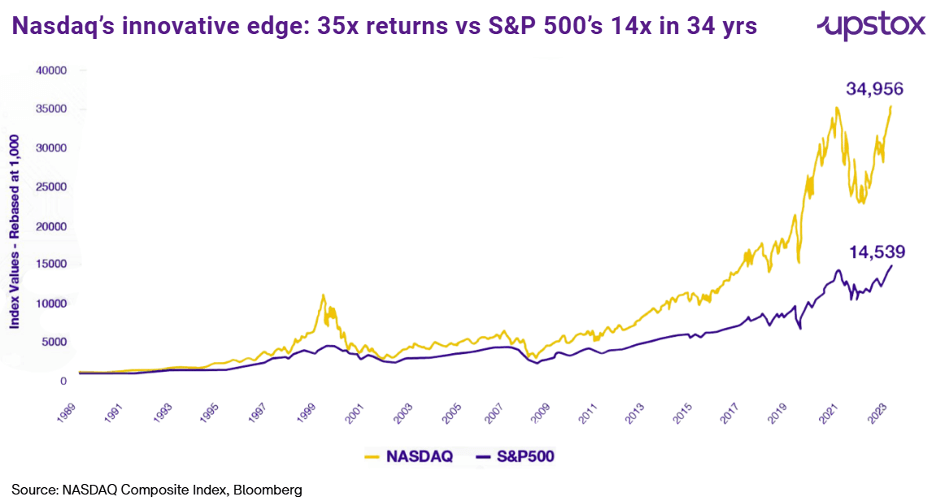Upstox Originals
Innovation-driven sectors leading India’s next growth frontier

9 min read | Updated on October 01, 2025, 15:54 IST
SUMMARY
Innovation is a powerful economic multiplier, with the NASDAQ outperforming the S&P 500 by over 35x in 34 years. India’s global innovation index ranking significantly improved from 81 to 39 by FY25, demonstrating strong progress in its technological ecosystem. Technologies like AI, robotics, gene editing, and nanotech are reshaping industries from retail to agriculture. India's surge in patent filings and global innovation rankings signals its readiness to lead in the innovation economy.

India’s global innovation index ranking significantly improved from 81 to 39 by FY25
Innovation drives economic growth and a competitive edge. It goes beyond flashy gadgets or high-tech breakthroughs. It is the continuous process of introducing new ideas, improving existing systems, and creating solutions that generate value.
Innovation encompasses many things like digital infrastructure, sustainable manufacturing, or healthcare delivery. In today’s fast-paced world, it's a critical tool for sustainable success.
For example, Silicon Valley, because of its innovation-led high-growth companies, contributes 1.5% of the US GDP. Nokia, Yahoo and Kodak failed to capture the innovation leading to their downturn, while in contrast Apple and Google stayed ahead by continuously evolving their products and adapting to innovation.
Over the last 34 years, the NASDAQ Composite has outperformed the S&P 500 by more than 35 times, underscoring the outsized returns delivered by innovation-first companies. What explains this massive divergence? NASDAQ is structurally tilted toward high-growth, innovation-led sectors-with technology companies making up over 50% of its weightage, compared to just ~27% in the S&P 500.

In India, UPI revolutionised India’s fintech as well as payment system enabling the largest real-time, low cost digital payments for all, opening the untapped digital economy.
How innovation catalyses economic prosperity
Countries like the United States, China, Japan, and South Korea have achieved rapid GDP growth during specific periods by fostering innovation in high-impact sectors.
The US leveraged IT and healthcare, China relied on electronics, smartphones and EV, Japan and Korea’s economic boom is because of consumer discretionary, materials and semiconductors.
Innovation-driven growth across countries and sectors
| Country | High growth phases | Real GDP growth (%) | Innovations areas |
|---|---|---|---|
| United States | 1983–2000 | 3.73% | Rise of personal computing, development of the internet, and e-commerce. Advances in biotechnology, the development of effective drugs |
| China | 2010–2024 | 6.70% | A manufacturing boom started the economy on a long term growth path. Today it is a leader in 5G technology, leading AI startups, and smartphone manufacturing Largest market for EVs, with companies like BYD and CATL dominating EV car and battery market |
| Japan | 1955–1970 | 9.65% | Rapid increase in demand for cars (32% annual growth 1965–70), rise of consumer electronics Innovations in high-quality steel production |
| South Korea | 1986–1996 | 9.42% | Rise in memory chips from 0% of world share in 1984 to 10.2% by 1993 Expansion in shipbuilding, 28.8% of global market orders, 3x rise in share of completed orders from 1982 Growth of the automotive sector, production up 7x (378,000 to 2.8 million units, 1985–96) |
Source: International Monetary Fund, Statista
Why India is at the cusp of Innovation: Key drivers and enablers
India saw the steepest jump in innovation ranking from 66th in 2013 to 39th in 2024 as per Global Innovation Index. India is at an inflection point in its innovation journey, driven by multiple factors like young population, robust digital networks:
Top Climbers in innovation rankings
| 2013 Position | 2024 Position | Improvement | |
|---|---|---|---|
| China | 35 | 11 | 24 |
| Türkiye | 68 | 37 | 31 |
| India | 76 | 39 | 37 |
| Vietnam | 85 | 44 | 41 |
| Philippines | 90 | 53 | 37 |
Source: Global Innovation Index Database, WIPO (2024)
Thriving entrepreneurial ecosystem
India is home to over 100 unicorns and 90,000+ startups, making it the third-largest startup ecosystem globally fostering innovation in new age businesses bringing solutions to unsolved problems.
High talent availability and demographic dividend
India adds over 2.24 million STEM graduates annually, with a median age of 28 years. The salary differential with developed nations also incentivises firms to set up innovation hubs in India. As per Techgig.com, the average salary in India is around ₹6-8 lakh, which can be higher than ₹50 lakh or even more in the USA
Government-backed digital infrastructure
India’s Digital Public Infrastructure (DPI), such as Aadhaar, UPI, DigiLocker, and ONDC, has been globally recognised as one of the most advanced enabling frictionless payment innovations across sectors, including payments and retail.
Policy push: PLI schemes and Atal Innovation Mission
Multiple flagship programs are catalysing innovation: PLI Scheme across 14 sectors attracting ₹4 lakh crore in investments. 10,000 Atal Tinkering Labs with 1.1 crore+ student participation through 72 Atal Incubation Centres are creating over 32,000 jobs. Startup India Mission further provides a comprehensive platform fostering innovation
Funding and institutional support
India witnessed $11.2 billion in VC/PE funding in 2024, despite global slowdown and muted trends in startup funding. The expansion of startup-focused credit (e.g., CGSS) and production innovation grants has ensured R&D-intensive sectors like electronics, green energy, and semiconductors continue growing.
Patent filings surged
India’s annual patent applications grew from 5,000 in 2000 to over 92,000 in 2024, reflecting both ambition and the rapid pace of R&D, as per the Ministry of Commerce.
Technologies that are driving innovation
Below are a few technologies that are driving innovation. While unfortunately they are not developed in India, they are being widely adopted and driving innovations across various sectors
| Technology | Sectors benefiting from respective innovation |
|---|---|
| AI | Retail, finance, manufacturing |
| Robotics | Manufacturing, resource mobilisation |
| Gene Editing | Pharma/biotech, academic/research, |
| Nanotechnology | Medicine, manufacturing, energy |
Source: HDFC
Below is a more detailed description of how these technologies are creating an impact across sectors.
Artificial Intelligence
-
Retail: AI-powered recommendation engines tailor product suggestions, promotions, and shopping experiences to individual customer preferences, increasing sales and customer loyalty. Predictive analytics forecast demand more accurately, optimising logistics and improving last-mile delivery efficiency. AI chatbots provide instant 24/7 support, freeing up human staff. We highlighted this in From shelf to screen
-
Finance: AI models analyse vast datasets to identify credit risks, detect fraudulent transactions, and flag suspicious activities with higher accuracy and speed. AI enables banks to offer tailored investment advice, loan products, and insurance policies based on individual financial behavior. Certain aspects of this were highlighted in our article From apps to wallets
-
Manufacturing: AI analyses sensor data from machinery to predict potential failures (predictive maintenance), reducing downtime. AI-powered computer vision systems automate defect detection on production lines, ensuring consistent product quality. AI algorithms optimise production schedules, resource allocation, and energy consumption. The importance of Internet of Things (IoT) is highlighted in the article Beyond the assembly line
Robotics
Modern robotics, often combined with AI and computer vision, can perform complex manipulations, navigate autonomously, and collaborate with humans.
Growth-driving innovations include collaborative robots (cobots) for human-robot interaction, autonomous mobile robots (AMRs) for logistics, robotic process automation (RPA), surgical robots, and specialised robots for hazardous environments.
For instance, robots handle dangerous materials or operate in extreme conditions in chemical or food processing plants, ensuring worker safety. They also ensure highly accurate measurement and mixing of ingredients for consistent product quality. In agriculture, robotics enables precision farming for automated planting, harvesting, and pest control.
Gene Editing
Gene editing technologies (like CRISPR-Cas9) drive innovation by allowing precise, targeted modifications to an organism's DNA. This unprecedented ability to "edit" genes opens up transformative possibilities in medicine, agriculture, and biotechnology.
It enables the correction of genetic defects, the development of disease-resistant crops, and the creation of new biological tools.
Gene editing enables the development of treatments that correct the underlying genetic causes of diseases, offering potential cures. It accelerates drug discovery by creating more accurate human disease models and can potentially lead to faster vaccine development.
Here are two simple, real‑life examples of diseases that have seen success using gene editing / gene therapy:
-
CRISPR Research on Blood Disorders & Blindness - Institutes like IGIB (Institute of Genomics & Integrative Biology) are exploring CRISPR-based approaches for β-thalassemia, hemophilia, and inherited eye disorders.
-
Climate‑Resilient Rice via Gene Editing - At NABI (National Agri‑Food Biotechnology Institute), researchers engineered Swarna‑Sub1 rice using CRISPR. This variety survives flash floods and resists stem collapse (lodging).
Nanotechnology
Nanotechnology drives innovation by manipulating matter at the atomic and molecular scale (1 to 100 nanometers). This allows for breakthroughs in areas like targeted drug delivery, advanced materials, and highly efficient energy systems.
Nanoparticles can deliver drugs precisely to diseased cells, minimizing side effects and increasing therapeutic efficacy. Nanosensors enable early and highly sensitive detection of diseases, facilitating rapid and accurate diagnosis. Nanocoatings on implants can improve biocompatibility and reduce infection risk.
Nanomaterials can significantly improve the efficiency of solar photovoltaic cells. Nanotechnology is crucial for developing next-generation batteries and supercapacitors with higher energy density and faster charging capabilities.
Two real‑world examples of nanotechnology applications:
-
Nanotechnology for Water Purification (Tata Swach) - The Tata Swach water purifier uses nano silver particles (nanotechnology) embedded in its filtration media to kill bacteria and purify water.
-
Silk Nanogel Injector for Drug Delivery - Scientists in Odisha and West Bengal developed a silk nanogel injector that slowly releases medicine at the target site, reducing side effects.
Innovation from risk perspective
-
Global competition & lost window - Countries like the US, China and Korea are aggressively pushing in semiconductors, AI, biotech etc. If India delays, it risks falling further behind in value‑chain capture and competitive edge.
-
Regulatory & policy uncertainty - Innovation thrives under stable rules. Frequent regulatory shifts or unclear frameworks (especially in AI, biotech, data) can deter investment and slow adoption of new technologies.
-
Intellectual property & data security threats - Weaknesses in IP protection or data regulation risk leakage of innovation, discouraging R&D. Also, increasing concerns over cyberattacks or misuse of AI threaten trust.
-
Infrastructure gaps - Having ideas is not enough. Without world‑class labs, fabs, testing facilities, and skilled manpower, many innovations may remain stuck in prototype and never scale.
-
R&D investment shortfall - Private firms globally spend 2–3× more as share of revenue in R&D than many Indian firms. Unless capital is channeled aggressively to R&D, the innovation engine won’t run full throttle.
-
Subsidy & policy capture risks - Overreliance on government subsidies can lead to misallocation, rent-seeking behaviour, or policy capture instead of genuine innovation.
To sum up
India's adoption of innovation is directly related to its growth trajectory. India is in a strong position to spearhead the next stage of global economic expansion thanks to its encouraging government policies, expanding talent pool, and rising investments in cutting-edge technologies. With enormous potential for long-term growth, industries at the forefront of this transformation include energy transition, healthcare, IT, defence, EMS, and automobiles (EVs). India can achieve significant economic growth in the upcoming decades by leveraging these innovations.
By signing up you agree to Upstox’s Terms & Conditions
About The Author
Next Story
